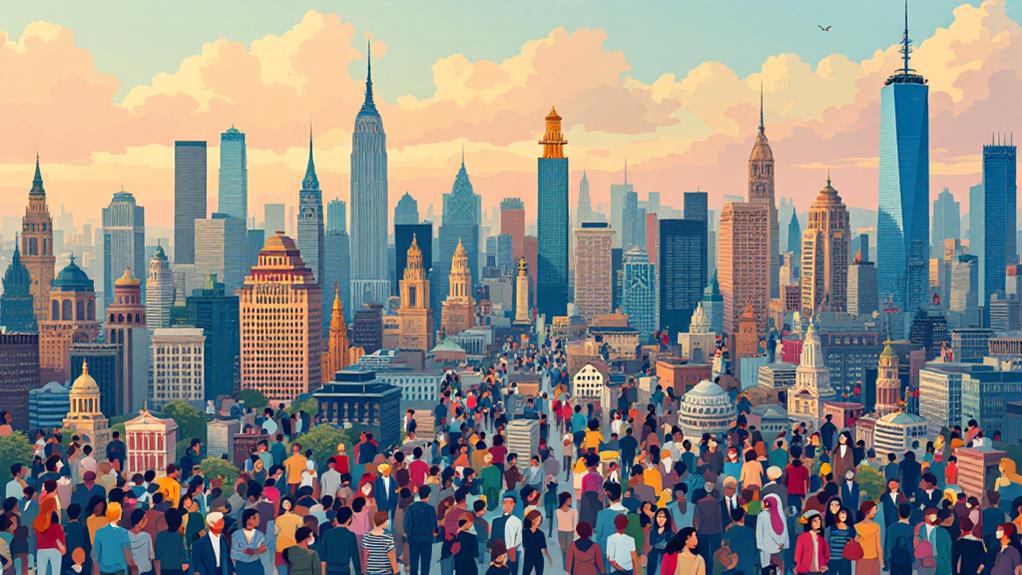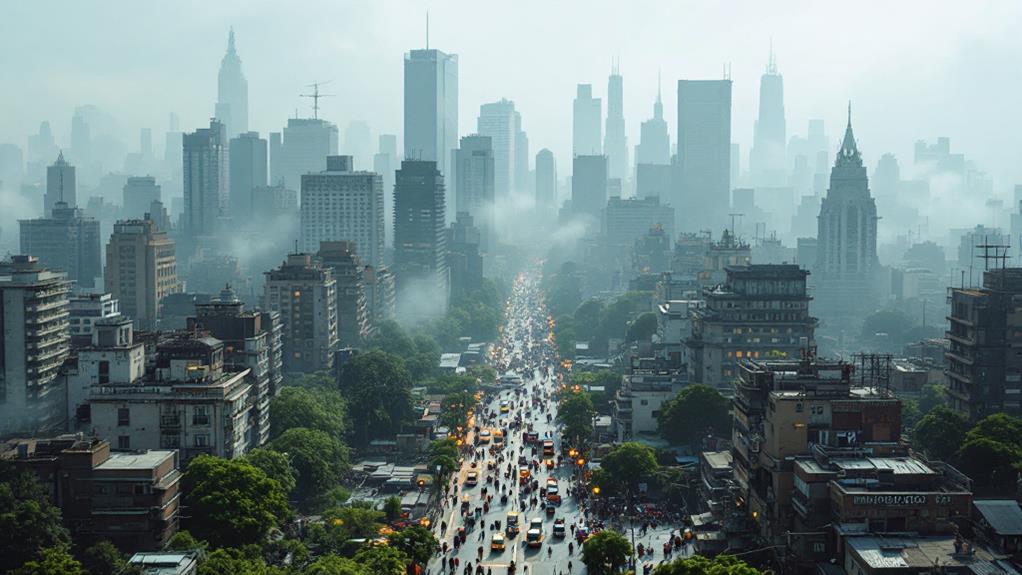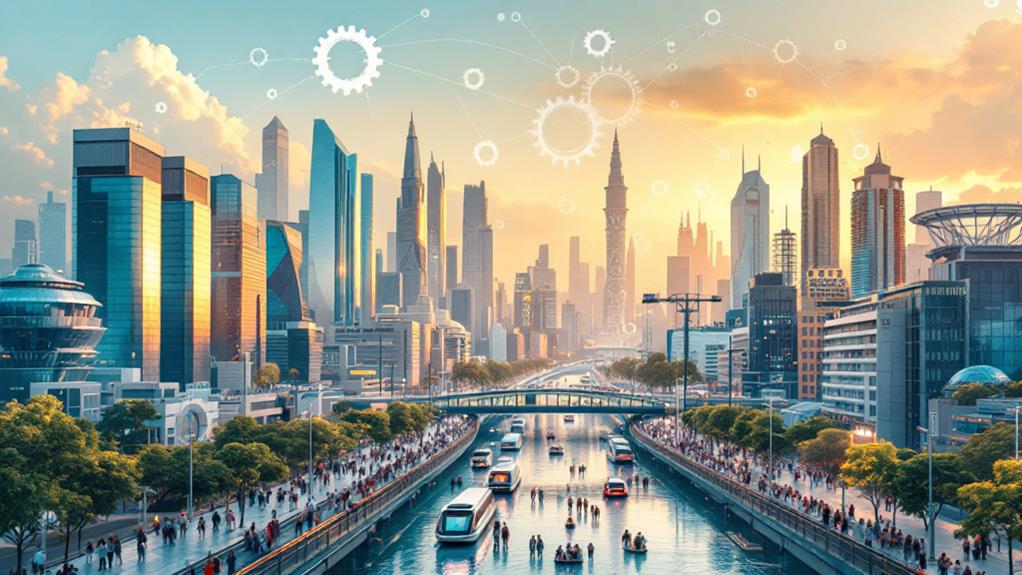How Migration Impacts the Growth of the Largest Urban Areas

Migration fuels urban growth by driving economic dynamism and increasing population density in major cities. As people flock to urban areas for better job prospects, they fill labor shortages and stimulate local economies. This influx often results in rising housing prices and pressures on infrastructure, requiring effective policy management. Migrants contribute to cultural diversity, sparking innovation and new business opportunities. Yet, the environmental impact and social integration issues remain challenges. As urban concentrations grow, especially in developing countries, successful integration strategies and sustainable policies become essential. Investigate how these dynamics shape the largest cities globally for further insights.
Migration Dynamics and Urban Growth
Migration plays an essential role in urban growth, especially in developing countries where it accounts for about half of the expansion seen in large urban areas. When you consider migration dynamics, you're looking at a complex interplay of factors that drive individuals and families from rural to urban settings. This movement considerably increases population density in cities, transforming them into thriving hubs of economic development. As urban populations swell, cities face mounting pressures on housing, employment, and public services.
In places like China, the easing of the hukou system has sparked one of the largest rural-to-urban migration waves, vividly illustrating how internal migration can reshape urban landscapes. Likewise, Vietnam and Ethiopia showcase how people migrate internally in search of better economic prospects, contributing to urban growth. However, this influx demands thoughtful migration policy to manage the challenges it brings. Without effective strategies, cities risk becoming unsustainable, burdened by inadequate infrastructure and insufficient public services.
Economic Restructuring and Opportunities
As cities swell with new arrivals, the focus shifts to economic restructuring and the opportunities it presents. Migration and urbanization have a profound impact on economic growth, particularly in developing countries. In nations like Vietnam and Ethiopia, internal migration drives the expansion of urban areas as individuals seek job opportunities in burgeoning industrial and service sectors. This influx of migrants improves the labor supply, effectively filling labor shortages and elevating economic dynamism.
Cities with high local wages attract migrants despite the higher living costs, fostering urban growth. This dynamic contributes to economic restructuring by redistributing labor and resources, promoting urban development. The presence of a robust labor force encourages investment and innovation, further propelling economic growth in these areas.
Remittances play an essential role in this process as well. Migrants, often working alone, remit significant portions of their earnings back home, impacting both urban and rural economies. Improved financial infrastructure for cross-border money transfers facilitates this flow, increasing disposable income for migrant households and stimulating local economies. These remittances influence investment patterns, supporting economic restructuring and improving urban development, ultimately creating a cycle of growth and opportunity.
Environmental Challenges in Urban Areas

Urbanization often brings complexity, especially in relation to environmental challenges. As cities grow due to migration and urbanization, they face considerable environmental degradation. Rapid industrial development and pollution contribute to resource stress, straining urban ecosystems. Urban growth increases the demand for natural resources, intensifying competition for necessities like clean water, energy, and land. This heightened demand can lead to severe ecological impacts, putting extra pressure on already stressed urban environments.
One in four urban residents lives in slum conditions, where inadequate housing and sanitation exacerbate health care and environmental issues. These conditions highlight the pressing need for effective public policies to mitigate the adverse effects of urban growth. Migration-driven population increases can result in higher greenhouse gas emissions, as transportation and industrial activities expand in densely populated areas. Addressing these emissions is vital to curbing the environmental toll of urbanization.
Public policies play an important role in tackling these challenges. Direct interventions, such as improving infrastructure and promoting sustainable practices, can greatly impact urban conditions. By focusing on sustainable urban planning and resource management, you can help create resilient urban ecosystems capable of supporting growing populations while minimizing environmental harm.
Social Integration and Adaptation
Social integration and adaptation are fundamental components of urban growth, especially as cities become more diverse with increasing migration. As a migrant, you might face significant socioeconomic disparities compared to native populations. These challenges can hinder your ability to integrate into urban communities effectively. However, don't be discouraged. Access to fundamental services like healthcare and education is critical for your social integration. These services help you adapt and participate more fully in your host community.
Local governments are instrumental in supporting your expedition. They offer mechanisms such as language assistance and community engagement programs that make the adaptation process smoother. By participating in these programs, you can connect with others and build a supportive network. Maintaining strong family connections is also significant. These bonds help create social networks that support your integration and counter the notion of complete detachment from your roots.
Over time, the educational and income gaps you initially face can narrow, especially for your children. Second-generation migrants often show reduced disparities, indicating successful adaptation within urban environments. By leveraging available resources and fostering community ties, you contribute to the colorful tapestry of urban communities, enhancing comprehensive urban growth.
Policy Frameworks for Urban Migration

Maneuvering the urban landscape as a migrant relies heavily on the policies that shape your experiences. Effective policy frameworks for urban migration prioritize social integration, making certain you have access to housing, healthcare, and education. These policies aim to create inclusive urban environments where you can thrive. Collaboration between national and local governments is crucial; local governments play a direct role in managing how migration impacts urban areas and their infrastructure.
Policies that encourage family migration can distribute immigrant settlement more broadly across cities, easing the strain on housing and services in densely populated urban areas. It's critical to support economic activity, as cities with better employment opportunities tend to attract more migrants, stimulating local economies and addressing labor shortages.
Tailored approaches are necessary for refugees and displaced individuals. Securing long-term support through employment opportunities, healthcare, and family planning helps improve their integration into urban settings. By focusing on these policy areas, cities can effectively manage migration, fostering environments where migrants contribute positively. These frameworks not only address immediate needs but also guarantee sustainable growth and integration in the urban landscape, benefiting both migrants and the communities they join.
Urban Concentration and Migration Trends
Migration patterns are reshaping the urban landscape, with immigrants flocking mainly to large, high-cost cities. These cities, although expensive, offer higher local wages and abundant job opportunities, drawing a notable share of the immigrant population. This migration trend contributes to urban concentration, where only a few cities house a large portion of these newcomers. By 2030, the rise from 33 to 41 megacities will highlight migration's impact, with these cities accounting for 14% of the global urban population.
The influx of immigrants affects multiple aspects of city life:
- Job Opportunities: Immigrants often prioritize employment over living costs, intensifying job competition in urban areas.
- Housing Markets: Increased demand leads to pressure on housing markets, pushing prices higher.
- Economic Activity: Remittance flows from immigrants greatly impact local investment and economic landscapes within cities.
- Urban Concentration: The growing immigrant population in megacities necessitates effective policies to manage urban concentration.
Understanding these dynamics offers insight into how migration trends shape economic activity and living conditions in urban areas. As immigrant populations continue to rise, finding a balance between opportunity and sustainability in these expanding urban centers remains vital.
Data Sources and Limitations

Despite their vital role in urban planning and public service delivery, migration data often face significant limitations, particularly in low-income countries. You'll find that disaggregated migration data is scarce, making it difficult to effectively plan for urban areas' growth and needs. International migrants are typically counted in censuses every decade. However, these census data often underrepresent irregular migrants, which creates gaps in understanding urban population dynamics. This undercounting can skew data, impacting how you assess urban growth and plan accordingly.
Population registers offer more timely information than censuses, allowing for a closer look at migration's impact on urban areas. However, they're less common in low-income countries, hindering real-time analysis. Surveys like the Demographic and Health Surveys (DHSs) provide valuable insights into migrant health and socioeconomic outcomes, yet they don't evenly cover every region, leaving some areas without reliable data.
A major issue you'll face is the lack of standardized definitions for urban areas and migrants. This inconsistency complicates data collection and makes it challenging to accurately assess migration's effects on urban growth. Addressing these data limitations is vital for informed urban planning and management.
Economic and Social Implications
In urban economies, migrants play a crucial role by filling labor shortages and propelling economic activity. They strengthen urban areas by contributing to economic development and cultural diversity. Migrants send significant remittances to their home countries, enhancing local economies and furthering development. Despite these benefits, urban areas face challenges like housing pressures and social integration issues. Here's why it matters:
- Job Opportunities: Migrants often prioritize employment in cities, even with high living costs, fueling urban growth and elevating economic activity.
- Cultural Enrichment: They bring diverse skills and backgrounds, sparking innovation and new business ventures, enriching the city's cultural fabric and economic landscape.
- Resource Strain: Increasing migrant populations can strain housing and public services, demanding effective migration policies to balance growth with integration challenges.
- Potential Transformation: With the right local government initiatives, migrants can transform urban areas into hubs of productivity and cultural exchange, maximizing their economic potential.
Understanding these implications highlights the importance of crafting migration policies that address both economic opportunities and social challenges. By focusing on integration, cities can harness the full potential of migrants, ensuring sustainable urban growth and a lively, inclusive community.



